AELITA
View the English Release of
this Russian Silent Film at:
http://www.youtube.com/watch?v=je1bIhS-7G8
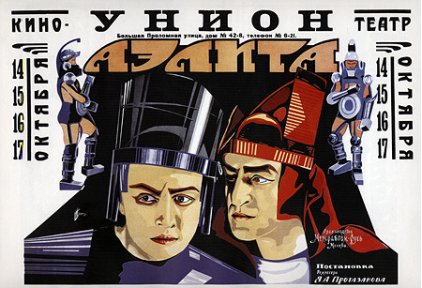
Poster for the 1927 Soviet movie, Aelita
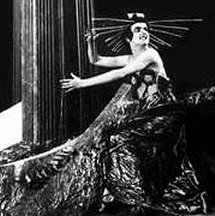 Aelita
is a sort of Russian Communist version of Burroughs' Princess of Mars,
written in triumphal soviet style, back in 1923 by Count Aleksei Tolstoy
(January 10, 1883 - February 23, 1945). Like many other Mars
stories of the age, there are elements that fit it into Barsoom.
At the outset, let me acknowledge James McLeary who wrote to kick me off
my lazy butt and take a look at this one.
Aelita
is a sort of Russian Communist version of Burroughs' Princess of Mars,
written in triumphal soviet style, back in 1923 by Count Aleksei Tolstoy
(January 10, 1883 - February 23, 1945). Like many other Mars
stories of the age, there are elements that fit it into Barsoom.
At the outset, let me acknowledge James McLeary who wrote to kick me off
my lazy butt and take a look at this one.
The plot is something we’ve seen
before. A pair of intrepid Earthmen wind up on Mars.
They discover a desert world of canals, the ruins of dead cities, strange
multi-legged monsters and eventually a human civilization which uses airships.
Learning the language, one of the Earthmen romances a Martian Princess,
who is torn between her heart and her duty. Meanwhile, a villain
with a prior relationship to the Princess puts in place his evil plan to
destroy both the lovers and the Martian civilization. The Earthman
leads an uprising, there’s a battle, aerial warfare, and a desperate flight
through catacombs filled with monsters. In the end, the Earthman
and his Martian Princess are tragically separated, but his heart remains
true to her.
Sounds a lot like Princess and some
of the other Barsoom books, doesn’t it? There are differences, as
befitting a Russian and a good communist. The villain in this case
isn't the Princess's prior betrothed, as in Dejah Thoris' plight.
Rather, it's Aelita's own father, Tuskoob. Instead of wild Tharks
and Warhoons and warring city states, there's merely class warfare and
socialist revolution in the one city. Okay fair enough.
Still, the resemblances are remarkable
enough to make you wonder if Aelita was inspired by Burroughs' remarkable
novel. Frankly, I don’t really know, but there's enough history to
make the possibility suggestive...
The
Other Tolstoy
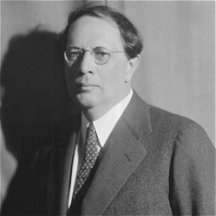 Aleksey
Nikolayevich Tolstoy was apparently a distant relative of Leon
Tolstoy. Born to something resembling a Tsarist Russian middle class
back in 1882, he appears to have fallen into literature and political radicalism
at around the same time. Russia back around the turn of the
century was as frustratingly backwards a society as you could get, with
a hopelessly antiquated and corrupt political system. So anyone
who spent more than five minutes looking around was going to turn into
a political radical. He started getting involved in social democratic
organizations, and taking part in demonstrations while only a teenager,
and almost got killed in a demonstration at the age of 19.
He became progressively more radical, coming to full fledged and devout
communism around 1921.
Aleksey
Nikolayevich Tolstoy was apparently a distant relative of Leon
Tolstoy. Born to something resembling a Tsarist Russian middle class
back in 1882, he appears to have fallen into literature and political radicalism
at around the same time. Russia back around the turn of the
century was as frustratingly backwards a society as you could get, with
a hopelessly antiquated and corrupt political system. So anyone
who spent more than five minutes looking around was going to turn into
a political radical. He started getting involved in social democratic
organizations, and taking part in demonstrations while only a teenager,
and almost got killed in a demonstration at the age of 19.
He became progressively more radical, coming to full fledged and devout
communism around 1921.
Thereafter, he evolved into a dedicated
Stalinist, and one of his plays was pretty blunt in its glorification of
Stalin and denunciation of Trotsky. By 1936 he was the head
of the Soviet Writers Union and in 1939 was elected to the Academy of Sciences.
That’s pretty vile when you think about it. In a period when Stalin
was indulging his most vicious purges and genocidal pogroms, this guy thrived.
That doesn’t say good things about his qualifications as a human being.
As a writer, Tolstoy came by it
honestly enough. There was that more famous and talented distant
relative, Leon Tolstoy, who did a little thing called War and Peace.
But there was more, his Mother was a free spirit and a writer of some small
repute. Aleksei wrote his first story at the age of ten.
By 1907, at the age of 25 he was publishing a couple of volumes of lyric
poetry. This was followed by prose work, short stories and
novels starting in 1911, and plays starting in 1913. His first play
was banned by the Tsarist authorities, which was probably a good sign.
He wound up as a war correspondent during WWI, but after that seems to
have gone back to novels and plays and remained there the rest of his life.
His writing showed an early bent
towards mining slavic folklore and mythology, I guess this would be termed
fantasy these days. Another running theme was historical works,
particularly Peter the Great and Ivan the Terrible. He
also wrote a lot of children’s stories. Although his official
biography lauds his commitment to 'realism' I have to wonder a little bit
myself. The emphasis on myth and folklore, historical works
and children's stories all suggest to me that here was a writer strongly
attracted to fantastic themes and settings. Who knows, it may
have kept him alive during the purges, when more strongly contemporary
writers found themselves off in labour camps.
Given his bent for the fantastic,
it should be no surprise that Tolstoy wrote a science fiction novel, Alita.
It must have been successful because he followed up with two more science
fiction novels,
Revolt of the Machines (no relation to Capek) and
Engineer
Garin’s Hyperboloid (IMDB).
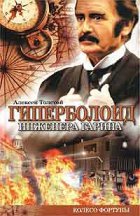
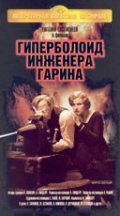
Engineer Garin’s Hyperboloid
book and 1965 film
I’ve slagged Tolstoy for thriving
in the Stalinist era. But to be perfectly fair, I’ll point out that
he wrote Alita and his other science fiction novels well before
the dark days of Stalinist excess. Alita dates from 1923.
What was happening back then? Well, the Tsar had been overthrown
by the Russian Revolution in 1917. The Great War had ended the next
year in 1918. But the new Soviet Union was beset by foreign invasions
from America, Japan, Britain and France as well as internal civil wars.
By 1921-22 it was all settling down, and in 1923, there was still a lot
of optimism that the Russian people were finally getting their act together,
were leaping collectively into the 20th century, and that they really could
and would build their socialist utopia.
Stalin had not yet come to power.
The Ukrainian famine was still to come. Things were fairly optimistic,
and beneath the veneer of 'socialist utopianism' there was a lot of flexible
experimentation. I doubt that Aelita could have been written
even ten years later.
The dark days were coming, but back
then, there was very little sign of them, just a lot of idealism and optimism.
Still, even for Tolstoy there seem to have been doubts, his short story,
"Azure Cities," from 1925, is about an engineer whose dreams of building
21st century cities are destroyed by socialist realities and planning.
But this doesn’t get us any closer
to seeing whether Tolstoy was influenced by A Princess of Mars,
does it? Sorry about that. Let’s return to topic.
It’s likely that somewhere out there, some historian of Russian literature,
or article or reference might be able to say definitely that Tolstoy read
Princess, which would settle things. Or it might contain some
definitive statement by Tolstoy that he had ‘most certainly not’ read Princess,
uh uh, Aelita’s completely original... which might not settle things.
Without anything definite, however, we’re forced to speculate.
Could
Princess Have Inspired Aelita?
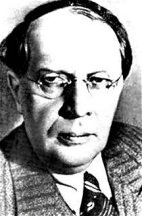 First
things first, whether Tolstoy ever read Burroughs, he was an educated man,
trained in engineering, and was almost certainly familiar with the same
science and pseudo-science of the day in regard to Mars. His
bent towards the fantastic almost certainly would have acquainted him with
the works of Percival Lowell. So Tolstoy’s knowledge was a
Mars of canals, a dying old world with dried or drying seas and endless
deserts and erosion, laced with canals, possibly inhabited by an ancient
race. It was the same template that other writers, from Burroughs
to Wells were drawing upon.
First
things first, whether Tolstoy ever read Burroughs, he was an educated man,
trained in engineering, and was almost certainly familiar with the same
science and pseudo-science of the day in regard to Mars. His
bent towards the fantastic almost certainly would have acquainted him with
the works of Percival Lowell. So Tolstoy’s knowledge was a
Mars of canals, a dying old world with dried or drying seas and endless
deserts and erosion, laced with canals, possibly inhabited by an ancient
race. It was the same template that other writers, from Burroughs
to Wells were drawing upon.
But was Princess of Mars
floating around Moscow or St. Petersberg for Tolstoy to read?
I don’t know, but it seems unlikely doesn't it. Princess
of Mars was published in North America in 1911. Was it translated
into Russian? If so, when? We know that Burroughs was
a popular underground figure in Russia, frowned upon by the formal authorities
who disliked his politics, but nevertheless much loved by those Russians
who just wanted a good story. So its possible that he did come
across it through Russian society.
But there’s more. Tolstoy
was a war correspondent for a Russian newspaper during the First World
War between 1914 and 1918. After spending time at the front,
he wound up reporting in both France and England. After returning
to Russia for a period of time, he was back in Paris by 1920, had relocated
to Berlin in 1921, and it was actually in Berlin that he wrote and published
Aelita.
Now this seems significant.
Because although we can wonder if Princess of Mars had made it to
Russia, we can be pretty sure that Burroughs story made it to Europe during
the first world war. It would have been a pretty simple matter
for copies to circulate in English-speaking Britain, or even re-publication.
France and Germany had strong ties with America, and could have received
or circulated American pulps, or re-published some of those stories, either
in original English or in translation. Even if they didn’t,
the vast numbers of English troops during the war in France, and the influx
of Americans towards the end, would have guaranteed that they brought their
magazines and novels with them. So it's almost certain that
copies of Princess of Mars were floating around. And would
have been floating around Paris and Berlin in the years after the war.
No guarantee that Tolstoy saw it, of course, but there you go, the possibility
must lay open.
One thing is that Burroughs Barsoom
was hot and current during this time. Princess of Mars may
have come out in 1911. But Gods of Mars was 1918, Warlord
of Mars was in 1919, Thuvia in 1920 and Chessmen in 1922.
So the series was both popular and mature. Its easy to conceive of
their popularity making them saleable in Europe.
And indeed, there’s good chances
that Tolstoy might have encountered other Martian adventures.
Almost certainly, he would have read Wells' War of the Worlds although
there’s little that might be Wells in Aelita. On the other
hand, Matthew Arnold's Gulliver Jones on Mars (1905) with its alien
princess and dying civilization was published in England. Gustave
LaRouge’s
Prisoner of Mars (1908) would have both been floating
around at about this time. Both of these have more than passing resemblances
to the later Princess of Mars.
On the other hand, Arnold’s Gulliver
Jones landscape is pretty normal and lacks the exotic desert feel that
Burroughs and Tolstoy give us. LaRouge's Prisoner lacks the
Princess and romantic plot, and his protagonist stumbles through a Martian
swamp, not a dry and empty world. Nevertheless, Tolstoy could
easily have been exposed to either of these.
There were other Martian adventures
that would have been floating around western europe while Tolstoy was there.
Unfortunately, Gustavus Pope’s ‘Journey to Mars’with its multicoloured
races and alien Princess probably wasn’t one of them, it was published
only in America back in 1894.
On the other hand, there was Griffin's
Honeymoon in Space (1901), Galopin's Doctor Omega (1905),
Torquet's Call from Another World (1906), Gayer's Serge Myrandahl
(1908), LaHire's
Conquerers of Mars (1911), Laurian's War of
Dwarves and Giants (1912), and others would probably all have been
floating around in British and French bookstores. These lacked many
Burroughsian elements found in Aelita, and were almost all in their
own way more fantastic than
Aelita. But I don’t think we could
definitively discount any of them.
It's also worth acknowledging Kurt
Lasswitz’s
Between Two Planets published in Germany in 1897, about
Earthmen encountering and being overwhelmed by a superior race of Martians,
although it's hardly Burroughsian. Tolstoy spent enough time in Berlin
that he might have run across it.
One guy who definitely wouldn’t
have been an influence was Otis Adelbert Kline, whose Martian novels were
published a decade later.
Anyway, we can’t say for sure that
Tolstoy actually encountered Princess of Mars, or any of the other
Martian adventures. But from what we know of his literary predilections,
it strikes me that Tolstoy would have probably been an avid reader of science
fiction and fantasy, particularly if he wound up writing the stuff.
And certainly, there's a good chance that it was floating around for him
to pick up.
The
Mars of Aelita
All right, fessing up here.
I’ve never read Aelita. I’d have loved to, but frankly, living
out here in the frozen wastes of northern Manitoba, wrestling polar bears
for food, it’s hard to access a lot of works. So, I just went
googling, and found a neat summary of Aelita right here: www.sovlit.com/aelita
Okay, it's not as good as actually
reading the book. But frankly, you probably don’t have the book to
hand either, and this at least gives some decent descriptions.
If it inspires you to eventually find it and read it, well, that's a good
thing.
The gentle reader is invited to
check it out. For myself, I'll simply restrict myself to a
series of observations and quotes, basically seeing how well we can fit
Aelita into Barsoom and related works.
First observation - there's a Jules
Verne/ H.G.Wells/ Tom Swift techno set up at the start. Not uncommon
in the SF of the period, kind of a time waster, but perhaps a necessary
part of suspending disbelief. Burroughs had the courage to
simply say 'he just winds up there, okay', but most writers of this period
put a lot of energy into trying to plausibly explain how one gets from
one planet to the other. This suggests a very strong awareness
of and influence by the nascent 'early pulp' sci fi writings of the west.
Arriving on Mars, our Russian heroes,
Los and Gusev get their first vision of the alien world:
"The Martian sun is large
and firey. The air is thin and dry. The spaceship lies on an orange-colored
flat plain. The land is overgrown with tall cactuses shaped like pronged
candlesticks. As Los and Gusev set off to explore, they find the walking
easy, even though their feet sink ankle-deep into the crumbling soil."
Sounds like a description of a dried
sea bed, with a layer of dried silt obscuring geographic or geological
detail. This is very much the desert, dessicated world of Lowell
and Burroughs.
"cactuses are standing
in neat rows. Los also discovers cockleshells, indicating that they are
at the bottom of a large, dried-up canal."
Interesting. Although the canal
is dried up, it's obviously still used for agriculture. There's
intelligent life on Mars, and the neat rows suggest that it's still around.
The crops of cactus in the canal
further implies that it contains moisture, at least some minimal amount
of moisture to sustain a crop. However, a canal is a transit for
water, it's not in itself a reservoir or oasis. This implies that
it may flow with water from time to time, at least enough to replenish
its soil for dry crops. So. . . seasonal flooding?
Seasonal flooding would put it in
the northern hemisphere, where the polar cap goes through dramatic expansions
and contractions. The southern polar cap is much more stable.
This would have been well known to astronomers of the time.
"In the distance, mounds
of stones, ruins, and snow-covered peaks are visible."
Snow covered peaks are reminiscent
of Burroughs' "Snow covered Artolian hills," which in turn we've associated
with the Tharsis volcanoes. By and large, Mars doesn't have a lot
of substantial mountains, so if you're looking for snow covered peaks...
well, the Tharsis Montes are your best bet.
This suggests that Aelita
is taking place in the seabeds directly to the west of the mighty peaks
of the Tharsis plateau, including Alba and Olympus.
Burroughs' city of Dusar is somewhere
in this vicinity, but for the most part, this is largely unknown territory
for Burroughs Barsoom. As nearly as we can sort Barsoomian
geography, he doesn't really set anything much in this area, or fill in
the map.
Interestingly, this is the general
area I've identified as being the most likely location for Kline's Outlaws
of Mars and
Swordsman of Mars. This includes the
Empire of Khalsifar with its capital city of Raliad. Of the other
Martian states identified by Kline, Nunt is in the south and Xancibar is
further west near Gathol. Most of Kline's adventures take place between
Xancibar and Khalsifar, in the western region.
So Aelita and her city would
be in the same rough geographic area, but well on the other side, much
closer to Tharsis in the East. The Tharsis highlands would
be a geographical barrier, limiting contact or communication with most
of Burroughs' Barsoomian nations. What we'd expect, therefore
is that Aelita's culture would probably be a bit more closely related to
Kline's cultures than the general run of Barsoom.
Of course, we've mentioned already
that Kline wrote his books a decade after Aelita. So
there's nothing deliberate there. And for the record, there's
no chance that Burroughs could have had any real information about actual
Martian geography, Burroughs had by 1923 barely begun filling in his own
Barsoom, and it's only a coincidence that we can relate either Tolstoy's
or Kline's Martian landscapes to any part of real Mars, or fit it into
Barsoom.
As I keep saying. It's just
a game. But it's fun.
Dead Cities and Canals, of course,
are a well established part of the 'folkloric' Mars of the era, going all
the way back to Percival Lowell. So these parts may not be borrowings
from Burroughs (and certainly not a borrowing form Kline), but merely another
instance of drawing from the same well. A common 'source' leads to
common results.
"After a few moments, the
creature descends and lands again. Los and Gusev now see that this is no
bird. It is a man-like being seated in the saddle of a flying machine.
Two curved mobile wings flap on either side of the rider, and a disc--a
propeller apparently--whirls a little below the wings."
‘Manlike being’ my hiney.
As we’ll see in Aelita, the Martians are fully human and apparently cross
fertile with terrestrial humans, if their own folklore is to be believed.
The flying machine is an ornithopter,
basically an aircraft that flies by flapping its wings, they’re basically
bird or bat machines. This increases the identification with
Kline's work. Kline, like Burroughs, had flying machines. But
Kline's flying machines were distinguished by flapping their wings, they
were ornithopter's or 'bird machines.' (although given their
mass, they probably employed the Barsoomian’s lifting ‘ray’ for bouyancy).
Burroughs used propellors or screws and lifting gas.
As Aelita goes on, we'll see that
ornithopter's are the common flying machines in the novel. The implication
here is that Aelita's culture is probably more closely related to Kline's
Martian cultures than mainstream Barsoom. Considering
our tentative geographical identification, this works nicely. It's
what you would expect.
"After lunch, the travelers
set off to do more exploring. Soon they have learned how to jump over the
cactuses with long, bouncy leaps."
Well, that's straight out of Princess
of Mars. Of course, lesser Martian gravity is a given, and practically
every writer who had his characters go to the Moon or Mars has them bounce
around in lesser gravity. But still, its suggestive.
"Three paces away is a
pair of eyes, as large as those of a horse, with drooping red eyelids.
There is an intense, deadly hatred in their piercing glare. Gusev whips
out his revolver and fires at it. It sprints away. Then they see another
one, getting a glimpse of its striped brown fat body moving swiftly on
long, spidery legs. It is the kind of giant spider that is found on Earth
on the bottom of deep oceans."
Exotic monsters, including oversized critters, giant insects
or a dinosaur-like beasties, were a common staple of interplanetary voyages.
So it certainly fits into the Burroughs traditions, and more generally,
into the traditions of pulp interplanetary adventures. But is there
a little more to it, or a little more that we could read into it?
A Banth? Or relative of the Banth? Note the
tiger striping, and the vertabrate style lidded eyes.
Okay, Barsoomian fauna is sprouting anywhere from six
to ten legs. A couple of Earthmen encounter a big predator with lots
and lots of legs. I think 'spider' might be a natural default way
to describe the thing. So, with an allowance or two,
we might conclude that what we're looking at here is actually a specimen
of typical Barsoomian predator.
Who knows, if Tolstoy actually read the Barsoom stories
he may well have visualized creatures like Banths and Ulsios, with their
many legs as spider-like predators. Burroughs himself doesn’t
spend a lot of time giving detailed descriptions of his various critters.
"They enter the building
and see a series of mosaics on the walls. The mosaics apparently depict
historical episodes-- battles between yellow-skinned and red-skinned creatures;
a manlike figure immersed in the sea, then flying amid the stars; battle
scenes and scenes of combat with beasts of prey; and scenes of domestic
life. A strange human head keeps recurring in the mosaic."
Wow. In the context of Barsoom, this is fairly
suggestive. A race of red skinned humans? A yellow race?
In Burroughs, of course, the dominant Martian civilization
is the Red Race, who have emerged after the sea beds have dried up.
The Red Race developed by the merging of other races, including the white,
yellow and black, and presumably warred with each of these parent races
as it came to rule the world. In Warlords of Mars, we discover
that the final refuge of the Yellow race, the Okar, is at the north pole,
which isn’t all that far from the general neighborhood in which Alita takes
place.
For the record, Kline gives us another yellow skinned
race, perhaps just a different breed of the same group, known as the Ma
Gongi. This race inhabits the swamps of Xancibar, way over
to the west of the ocean bed. Both the Ma Gongi and the Okar are
still fairly hostile to the dominant population. Again, this
goes to imply that the general region between Tharsis and Elysium might
have been a former stronghold of the Yellow Race.
Generally, this area of Mars, in both Kline's and Burroughs
description, seems to be an ethnic refuge. In the outskirts of this
region, Burroughs locates his yellow Okar at the pole, a surviving population
of Orovars in the ruins of Horz, and an outpost of Blacks in Kamtol.
The closest Polar city is Panar, perhaps originally ruled by the Okar but
now a Red nation. Meanwhile, Kline has a surviving white population
in Xancibar, and a Khalsifar nation which is mostly brown, a mixture of
black and white races, with a few pure blacks left.
Overall, this is an area where you might well expect some
race based warfare, or a struggle between yellow and red. Indeed,
if Panar was originally an Okar city (as its dome and technology seem to
suggest), then the fact that its now a red city suggests that just such
a conflict may have happened.
Since these are ruins on a dried sea bed, we can assume
that these murals were painted well after the seas dried and the Orovar
age ended, and during the period in which the red race was ascendant.
So these murals can be interpreted as depicting Barsoomian history.
Other bits of Barsoomian history? Remembrances
of the sea? A coincidental allusion to the face of Cydonia?
"The Martians are horrified
when Gusev takes out a cigarette and starts "swallowing smoke".
This is very similar in concept to a couple of scenes in
Kline's Outlaw of Mars, where Jerry Morgan, the earthly protagonist, astonishes
and induces religious awe in the Martians by smoking a cigarette.
This is perceived by the Martians as a sign of divine contact or affiliation,
with their Sun God, Sarkiss. Later on in Aelita, we'll see
that there may be similar religious/mystical overtones to the act of smoking
or inhaling burning vapours.
In real terms, this is absolutely a coincidence.
Or if anything, its Kline somehow borrowing from Tolstoy. Realistically
though, this sort of thing falls into the category of the ‘white man’s
magic’ cliche, where westerners astonish the locals with commonplace tricks.
But, once again, this suggests an affinity between Aelita's
culture and Kline's cultures.
"After they pass some mountains,
the landscape changes dramatically. A broad shining plain, which the Martian
calls 'Azora' is dotted with sparkling lakes, rippling canals and
jolly canary meadows ... all like the little spring meadows one dreams
of as a child. Wide metal barges ply the canals."
Interesting. I've got a character named 'Azara' in
a pastiche I did called Torakar
of Mars (originally Lesbians of Mars.) Absolutely nothing
stands on it, but it's interesting.
Elsewhere in the novel, the great mountains are known
as Liziazira, or Lizi-Azira. Close enough to suggest that Azara is
a root word, perhaps meaning lands or a specific land. Lizi may mean
mountains, or perhaps a place related to the specific land.
Meanwhile, Burroughs never makes reference to River Barges,
but Barge traffic is well established in Kline's novels. So once
again, there's another affinity to Kline's Martians. . . purely a coincidence,
but it works for us. Again, not too much stands on it.
Canals naturally imply boats and barges.
But it is interesting how our read of the geography places
it close to our guesses for Kline’s locations, and independently, we can
find a number of affinities to Kline's Martian cultures.
Where are we now? Well, they're moving away from
the Tharsis Montes, so travelling west by air, probably at a decent altitude
because they've got a pretty good view of the terrain. The
mountains that they pass aren't the big snow capped ones in the distance,
but rather, smaller mountains passed along the way. They may
well be high jagged walls of large craters. There are quite
a few of them in the neighborhood, Note that they don't seem to be passing
over them or through them, but simply observing them in the distance.
The landscape becomes more fertile and well watered, so
my assumption would be that they're descending to a lower elevation...
the place where the canals may drain too. I note that they
started off on a flat sea bed plain, and except for the mountains, the
sloping is pretty gentle, but definitely there. There's no indication
that they're passing any cliffs or the remains of continental or submarine
shelfs.
Based on all the foregoing, I'd put them around here on
the Mola map:

http://ltpwww.gsfc.nasa.gov/tharsis/Mars_topography_from_MOLA/M_-150_-140_40_50.html
for reference, here's the full Mola Map:
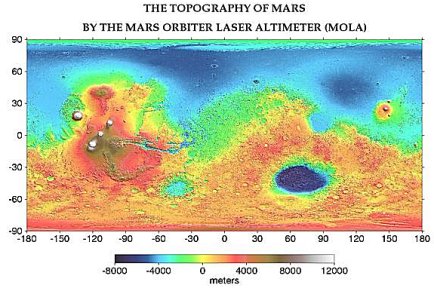
http://ltpwww.gsfc.nasa.gov/tharsis/Mars_topography_from_MOLA/
The likely location is just to the north and west of Olympus
Mons, the biggest Tharsis volcano. Roughly Minus 150 and 45.
From this area, you'd see Olympus, and Alba Patera, and perhaps a few of
the Tharsis Montes as immense snowcapped peaks in the far distance.
But you’d be on a flat sea bed which descends gently to a deeper plain.
"The bald Martian leads
Los and Gusev into a luxuriant copse, filled with weeping, azure-blue trees.
A peaceful herd of short-legged, long-haired animals grazes nearby. Water
gurgles, completing the idyllic scene....They descend a moss-covered staircase
to the shore of a lake. A slim, young woman in a yellow pointed cap appears
on the stairs. The bald Martian whispers, "Aelita", covering his eyes and
dragging Los and Gusev off the path and into the copse."
These Martians seem overdressed for Burroughs habitual nudists.
But then again, the evidence suggests that they're at a relatively temperate
northern latitude. So maybe that's understandable. In Burroughs,
fur bearing animals are only found in the northern climes, so the grazing
herd would tend to support the northern identification. Note the
reference to 'moss' here. Moss is big with Burroughs, but I haven't
seen a lot of references previously.
"Twenty thousand years
ago, Tuma, or Mars, was populated by a people called the Aols, the Orange
Race. Some were hunters, some were fishermen, etc., etc."
Tuma seems phonetically related to Barsoom. In Barsoomian,
'Soom' or 'Oom' seems to be a root or suffix meaning world or place, thus
other planets are Jasoom and Cosoom. In Carter's Callisto, which
may be related to Barsoom, aliens races Yathoon and Zarkoon appear to have
the common root or suffix 'Hoon' or 'Oon.'
In Barsoomian, adding an 'a' or 'ia' at the end of a word
denotes a feminine context, either neutral feminine, or perhaps mother
or daughter. So, 'uma' or 'Oom-a' would translate as 'Mother-world'
which is a pretty understandable term. The 't' sound which
prefixes may just be a local accent, or it might be a religious Tur allusion.
'Holy Mother World'. I could see this as being a valid local
term for the world, after all, we call our planet ‘Earth’ and ‘Terra’ and
‘the World’ respectively, so it wouldn’t be surprising if the Barsoomians
had some flexibility too.
In more prosaic terms, calling Mars 'Tuma' strikes me
as one of those bits of 'cleverness' that gives me a strong feeling that
Tolstoy has read
Princess of Mars. It's close enough to be
evocative, and yet it has the feeling of being deliberately consciously
just a little bit different. As if he started off with Barsoom and
changed it a tiny bit to make it his own.
There's another possible word affiliation, this time absolutely
coincidental, with Otis Adelbert Kline's Mars. In Kline's Outlaw
of Mars, the sun god (Tur for most of Barsoom) is called Sarkiss.
Iss of course is the name of the successor River/Afterlife cult and Goddess.
This suggests that a part of the word Sarkiss might be the word for ‘sun’
itself, either ‘Sar’, ‘Sark’,
Now, if we look to Aelita, there's a word for 'sun'
which is given as Soatsr, or phonetically 'Soat-Sar'. Aelita's city
is called Soatsera, which translates as City or Settlement (sera) of the
Sun (soat-sar). But the point is that ‘Soat-Sar’ for sun, may well
be related to Kline's 'Sar' or 'Sark'. Absolutely a coincidence
of course, and certainly there’s no way it could be intentional for either
Kline or Tolstoy. But suggestive, nevertheless.
Finally, here’s a real long shot: Oeyeo in
Aelita's Mars translates as 'concentrate', this is vaguely similar to the
name for CS Lewis’ Malacandran being ‘Oyarsa’ who might be a creature produced
by psychic concentration, like the bowmen of Barsoom’s Lothar. As
I’ve said, this is such a long short its hardly worth the mention.
By the way, James McLeary was kind enough to compile a
list of Martian words found in Aelita for me, and I scrounged up a few
more names and such from the Russian Lit summary. There’s some
indication that some of these words relate to each other, as in Azora and
Lizi-Azara, which is linguistically satisfying. But these were the
only words that I could relate, one perhaps deliberate, one definitely
accidental, both a bit suggestive.
On the other hand, many of the Martian words in Aelita
are for concepts or descriptions that have no clear analogue in the Barsoomian
words given to us by Burroughs or Kline. So its quite easy to say
that these are simply additional Barsoomian words, if that's your bent.
The 'orange race' is another tip off that there may have
been some awareness of Princess of Mars. It's like Tolstoy
was aware that Burroughs had used all the good colours, and was consciously
choosing something he hadn't used.
In any event, from here we go into a great historical
digression about how the peaceloving orange Martian aols were overrun by
white (or perhaps black) Earthlings from Atlantis. The Atlanteans
came, kicked the Martians out of their fertile lands and settled down.
Then they realized that they hadn’t brought any Atlantean women with them
(what an oversight!), and so they let the Aols back provided they provided
women. The Atlantean culture built the canals and city, but alas,
their civilization died out and the locals were left unable to even read
their books or match their technology until recently.
The general narrative of an ancient civilization reaching
great heights which its descendants cannot match is a pretty typical Barsoomian
trope. On the other hand, this doesn’t really fit with what we know
of Barsoomian history. Can we reconcile it?
Possibly, its an accurate record, and simply describes
what happened in the local neighborhood. Or, what we have here, possibly,
is something which by Aelita’s own admission, is ancient, ancient hearsay.
So while it differs from what we know of Barsoom, it might hardly be accurate.
It seems a fair part of the book is devoted to ancient
Martian/Atlantean history. In later chapters, we learn about the
first civilization of black men on Earth, their construction of pyramids
and wonders, their usurpation by semitic types, the coming of red and yellow
races and development and fall of Atlantis. Apparently there's nothing
much going on on Mars at this time. This focus by Aelita on
Earth history seems peculiar.
So peculiar that I find myself wondering if our Russian
protagonists aren't receiving very garbled messages. They've only
learned the language a few days ago, so they may well be confusing the
history that's given to them. Or possibly, as noted, its Aelita’s
own histories that are a confused jumble of legend, folklore and history.
Or possibly its accurate, but the parts that pertain to Mars describe merely
local conditions quite different from the general run of Barsoomian history.
In Burroughs, of course, the first race of Martians and
the first bearers of civilization are the Black race, supplanted by the
Orovars, who hang on in this particular region, but who are challenged
by both the Red and Yellow races. This suggests that perhaps
the Russians receiving or misinterpreting a history of Barsoom, and because
of their inexperience with the language, confusing it with Earth and Atlantis.
Tolstoy likely intended this history to jibe with the
Murals his adventurers see early in the novel. But those Murals could
just as easily be interpreted in terms of the Barsoomian history we know.
In any event, I small the hand of Mme. Blavatsky and her
Theosophist histories in here. Blavatsky was an Eastern European
crank whose writings were popular in the turn of the century. It
seems that there was a whole vogue of these politically/mystically inclined
'hidden histories.' So clearly, Tolstoy is drawing on these sources
and giving it a neat socialist morality tale gloss.
It's worth noting that some sources suggest that Burroughs
may have been influenced by some theosophical works. Among Blavatsky's
previous races were a red race with flying machines, and four armed giants.
"No one is allowed to watch
the secrets of the Supreme Council, she says, adding that she'll be exiled
to the snowy regions if anyone ever finds out."
There's some plot development here that I don't worry about.
What's significant about this passage is exile to the snowy regions.
This again argues for a fairly northern placement of Soatsera and Aelita's
culture. Northerly enough that exile to the polar caps 'snowy regions'
is a realistic punishment.
"There are reports that
there will be a clash that evening in the Supreme Council between Tuscoob
and Engineer Gor, the leader of Soatsera's workers."
Gor or Gur is a not uncommon Barsoomian name. It's
a minor thing, but what the heck.
After that, it gets all ideological when our heroes lead
a socialist uprising. But there's all sorts of Burroughsian touches,
including a torrid romantic subplot with the Princess Aelita (who like
Dejah Thoris inflicts Martian dating customs on the hapless earthlings),
a journey through catacombs, and encounters with a horde of cave spiders.
In short, there's much that is reminiscent of Burroughs
Barsoom stories. Doesn't necessarily mean that Tolstoy borrowed from
Burroughs. It's definitely suggestive, but hardly proven.
But on the other hand, from what we can see and
determine from our limited exposure, Aelita's geopgraphy and culture seems
to fit in neatly and organically with the map of 'greater barsoom' which
we've been developing. And that's pretty satisfying.
The
Further Adventures of Aelita
Tolstoy never returned to Mars, of course. But Aelita
turned out to have a life of her own. In 1924, the Soviet Union
made the novel into a silent feature film, Aelita:
Queen of Mars one of the earliest Science Fiction films, and the
first soviet SF film.
Never having seen the film, I can do no better than to
quote Fiona Kelleghan’s synopsis over at the internet movie database:
“This is called the first
Soviet science fiction film because of its "futuristic" sets on Mars, although
most of it takes place in Moscow. The movie is set at the beginning of
the NEP (New Economic Policy) in December, 1921. A mysterious radio message
is beamed around the world, and among the engineers who receive it are
Los, the hero, and his colleague Spiridonov. Los is an individualist dreamer.
Aelita is the daughter of Tuskub, the ruler of a totalitarian state on
Mars in which the working classe are put into cold storage when they are
not needed. With a telescope, Aelita is able to watch Los. As if by telepathy,
Los obsesses about being watched by her. After some hugger-mugger involving
the murder of his wife and a pursuing detective, Los takes the identity
of Spiridonov and builds a spaceship. With the revolutionary Gusev, he
travels to Mars, but the Earthlings and Aelita are thrown into prison by
the dictator. Gusev and Los begin a proletarian uprising, and Aelita offers
to lead the revolution, but she then establishes her own totalitarian regime.
Los is shocked by this development and attempts to stop Aelita, and then
reality and fantasy become confused, and Los discovers what has really
happened.”
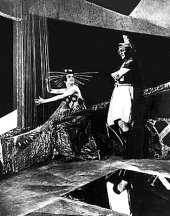 The
whole thing turns out to have been a dream (gasp!). Seems somewhat
different from the novel. That bit of 'cold storage' is coincidentally
reminiscent of Panar in Llana of Gathol, but it doesn't appear in
the novel. Gusav of the novel becomes a supporting character,
his role largely abandoned or usurped by Spiridinov. Aelita becomes
a fantasy figure with no clear dramatic purpose, and Los' pining for Mars
is confusedly seen as escapism. It’s noteable that even a few years
later, we can see that the Soviet ideological extremism has grown more
virulent.
The
whole thing turns out to have been a dream (gasp!). Seems somewhat
different from the novel. That bit of 'cold storage' is coincidentally
reminiscent of Panar in Llana of Gathol, but it doesn't appear in
the novel. Gusav of the novel becomes a supporting character,
his role largely abandoned or usurped by Spiridinov. Aelita becomes
a fantasy figure with no clear dramatic purpose, and Los' pining for Mars
is confusedly seen as escapism. It’s noteable that even a few years
later, we can see that the Soviet ideological extremism has grown more
virulent.
The few stills I’ve seen show remarkable and vivid costumes
and sets for Mars. Aelita's design may well have influenced the later
Flash Gordon serials. On the other hand, goofily, it appears
that Aelita herself was costumed to make it appear as if she had one eyebrow
and three breasts! Dejah Thoris, eat your heart out.
Sadly, it appears that only 15 or 20 minutes of the 110 minutes running
time actually finds our heroes on Mars.
One of the alternate titles for Aelita is Revolt
of the Robots which is the title of Tolstoy’s second science fiction
novel. This might suggest that he did return to Mars after all, although
if he did, its not clear what if any of that plot wound up in the film.
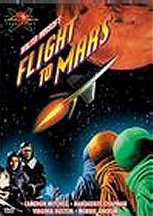
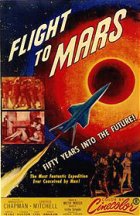
Finally, in 1950, a low budget American production company
named Monogram made Flight to Mars, which featured a Martian
Princess named Alita. Pretty much everyone acknowledges that
the name comes from either the Russian film or novel. Some
go further and argue that the whole of the movie itself is based on Tolstoy’s
novel (no one as far as I can tell, has ever suggested that they ripped
off the Soviet film). In this regard, I’ll quote John Costello from
Peabody, MA, who wrote on the Internet Movie Database:
"This film is the American
version of Aelita, from the novel by Count Alexei Tolstoy (the less famous
of the writing counts Tolstoy) and the first version of the novel is worth
reading (he later did many more versions to try to please Stalin, but that's
another story.). The American version is in many ways a faithful retelling
of the novel done under a low budget. There is the engineer with the unhappy
love-life, the revolutionary has been replaced by the reporter (who was
in the book too), and Aelita becomes Alita, a Martian engineer with a slip
stick as long as her arm. .... The basic story line and character line
up were retained, with the exception of the professional revolutionary
who got dropped. In the book the reporter appears at the beginning and
end of the narrative, and does not accompany the characters to Mars. In
the book the engineer was married, not afianced. Of course, the Russians
also filmed Aelita as a silent. What is interesting is that the American
version is more faithful to the original plot."
Actually, this film I’ve seen, and I think that Mr. Costello
is stretching a bit. Take out the ‘revolutionary’ and seriously,
what do you have left? It strikes me Flight to Mars
is a pretty conventional SF potboiler for its period, so resemblances to
Tolstoy’s novel may or may not be coincidental, but hardly amounts to much.
For the record, although the novel itself fits neatly
into the greater Martian landscape we’ve charted for Burroughs, Wells,
Kline, Lewis and others, I wouldn’t attribute either film version
to Barsoom, Greater or otherwise. But we certainly hope that you’ve
enjoyed this little excursion.
~ A 7,000-word article
by Den Valdron
ERBzine: AELITA PRINCESS OF MARS
A Thumbnail Gallery of Aelita
Art by V.A. Bylinkina
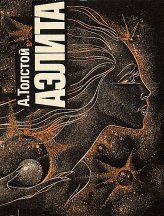
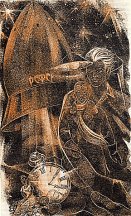
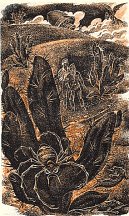
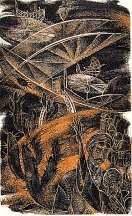
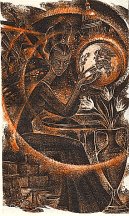
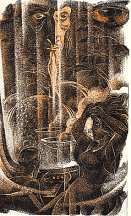
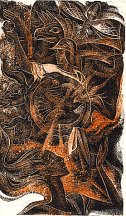
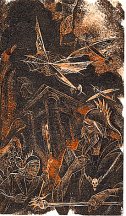
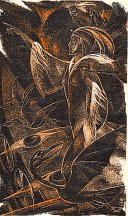
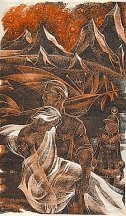
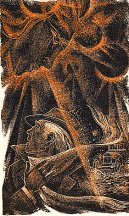
www.erbzine.com/mag17/1742.html
See the full-size images and
read the Aelita story summary at the
SovLit.com
site
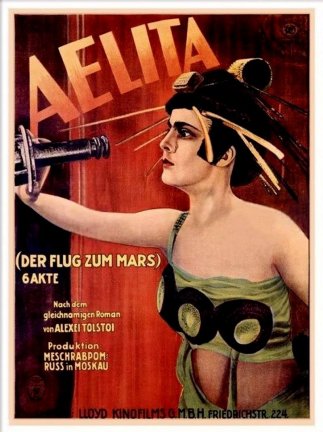
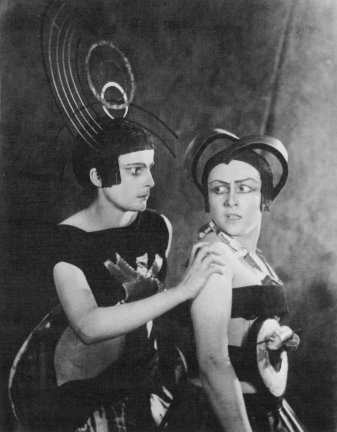
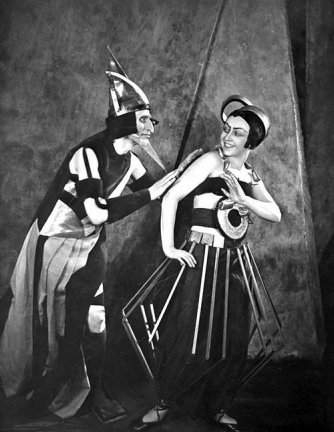
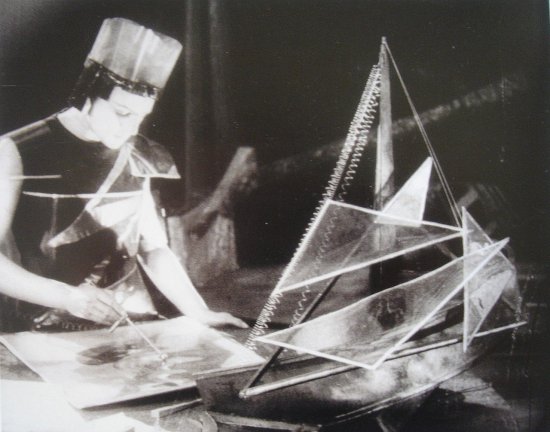
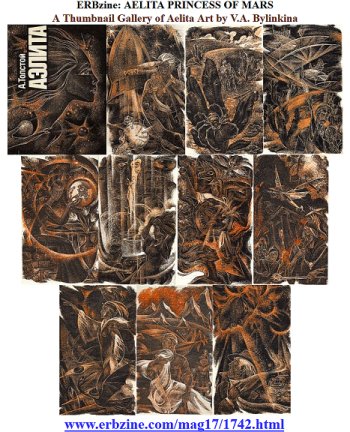
Appendix
- Martian/Barsoomian Words from Aelita
(compiled by James McLeary)
Ae, seen for the last time
Aols, the Orange Race of Mars
Ash kkheh, second sight or psychic ability
Azora, joy/ homeland
Ho, and
Khao, emotion and chaos triumphing over reason
Khavra, an intoxicating smoke
Lita, starlight
Liziazira, mountains
Magatsitl, ruthless
Oeyeo, concentrate
Ro, water
Sera, settlement
Shoho, men
Soatsr, sun
Soatsera, name of principle city
Sua, remember
Taltsetl, Earth
Tuma, Mars
Aelita - Martian princess, love interest for Los
Tuskoob - Martian leader, Aelita’s father, head of the
Council.
Gor - Martian engineer and revolutionary
Ikha - maid, love interest for Gusav
Magr - ancient Queen.
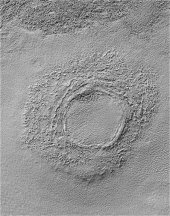

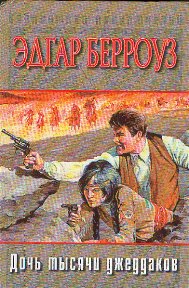
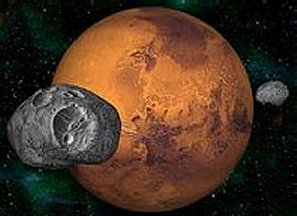
![]()

![]()